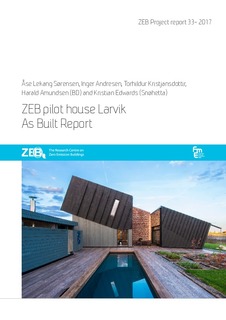| dc.contributor.author | Sørensen, Åse Lekang | |
| dc.contributor.author | Andresen, Inger | |
| dc.contributor.author | Kristjansdottir, Torhildur | |
| dc.contributor.author | Amundsen, Harald | |
| dc.contributor.author | Edwards, Kristian | |
| dc.date.accessioned | 2018-03-05T16:53:56Z | |
| dc.date.available | 2018-03-05T16:53:56Z | |
| dc.date.created | 2018-02-22T12:09:23Z | |
| dc.date.issued | 2017 | |
| dc.identifier.isbn | 978-82-536-1552-3 | |
| dc.identifier.issn | 1893-157X | |
| dc.identifier.issn | 1893-1561 | |
| dc.identifier.uri | http://hdl.handle.net/11250/2488768 | |
| dc.description.abstract | This report describes the ZEB pilot house Larvik, which was constructed during the autumn 2014. The ZEB pilot house is a two-storey single-family residential building situated near Larvik, Norway. The building was designed by Snøhetta, Brødrene Dahl, and Optimera for demonstration purposes, to showcase and test energy solutions for energy-efficient and plus-energy buildings. The report describes the building design and major design choices, the building services, the energy supply system and estimated energy need and delivered energy, the operational energy performance, the greenhouse gas (GHG) emissions from materials, as well as the ZEB balance. Further, the report presents information about the indoor climate performance, the design and construction processes, and information about costs. The ambition level of the building was ZEB-OM, which means that all GHG emissions related to all operational energy use (O) plus embodied emissions from the materials and technical installations (M) are to be compensated for by on-site renewable energy generation. In addition, the building should supply enough energy for an electric car. An interdisciplinary project team has been involved in the design and construction process. Research was made to reduce the emissions from construction materials, as well as to investigate their ability to contribute to a good indoor climate. A number of active and passive energy measures are demonstrated in the residence. Lessons learned from the project can be helpful for other building projects with ambitious goals. The energy generation system is based on roof mounted photovoltaic modules for electricity and a combination of different heat sources for thermal energy: a ground-source-to-water heat pump, an airto- water heat pump in the exhaust of the ventilation shaft, a solar collector system, and two different grey water heat recovery systems. The calculations show a net energy need for the building of 17,348 kWh per year, or 86.1 kWh/m2 of heated floor area. The demand for delivered energy is reduced due to the different heat sources for thermal energy. The remaining demand for delivered energy was calculated to 7,142 kWh electricity per year, or 35.4 kWh/m2. The calculated production from the photovoltaic system is in total 19,200 kWh per year. The GHG emissions are calculated to be 2,650 kgCO2 eq per year over a 60-year lifetime, or approximately 13.2 kgCO2 eq/m2 per year. It is estimated that 36 % of emissions come from operational energy use (B6), while 52 % of emissions come from building materials and replacements (A1-3+B4). 12 % of emissions are connected to the use of the electric car. The calculated emission balance gives a close margin on the ZEB-OM ambition for the ZEB-pilot house Larvik, but not when including 12,000 km with the electric car. Reducing the use of the electric car to 7,600 km gives a balance in the calculated emissions, given the described conditions. The approach is sensitive to methodology for material emission accounting and the choice of electricity emission factors for the import and export of electricity. | |
| dc.description.sponsorship | This report has been written within the Research Centre on Zero Emission Buildings (ZEB). The authors gratefully acknowledge the support from the Research Council of Norway, BNL – Federation of construction industries, Brødrene Dahl, ByBo, DiBK – Norwegian Building Authority, Caverion Norge AS, DuPont, Entra, Forsvarsbygg, Glava, Husbanken, Isola, Multiconsult, NorDan, Norsk Teknologi, Protan, SAPA Building Systems, Skanska, Snøhetta, Statsbygg, Sør-Trøndelag Fylkeskommune, and Weber. | |
| dc.language.iso | eng | |
| dc.publisher | SINTEF akademisk forlag | |
| dc.relation.ispartofseries | ZEB Project report;33 | |
| dc.subject | Zero emission building; ZEB | |
| dc.subject | Case study | |
| dc.subject | Evaluation | |
| dc.title | ZEB pilot house Larvik. As Built Report | |
| dc.type | Research report | |
| dc.description.version | publishedVersion | |
| dc.rights.holder | © 2017 SINTEF Academic Press and Norwegian University of Science and Technology | |
| dc.subject.nsi | VDP::Technology: 500 | |
| dc.source.pagenumber | 107 | |
| dc.source.issue | 33 | |
| dc.identifier.cristin | 1567879 | |
| cristin.unitcode | 7401,30,20,0 | |
| cristin.unitname | Bygninger og installasjoner | |
| cristin.ispublished | true | |
| cristin.fulltext | original | |
